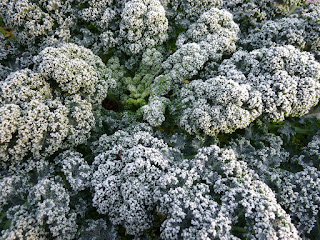 |
| Final squash harvest |
The frogs and bees have gone into hibernation, almost all the leaves are down. There is more darkness, even if the supermoon provided some extra night light. A good time for a garden clean-up before a bit of winter rest. Just to be able to put all the squash plants on the compost bin, Jim had to dig over the whole row of bins twice! And he's even started digging some of the cleared vegetable beds.
 |
| Pile of squash plants |
 |
| Frosted kale, should be sweeter now |
The last of the squashes and beans have been harvested. This time I shelled the large runner beans, which were pretty in pink and purple. They weren't quite dry yet, but good enough to freeze. The naked beans turned out to be so delicious that I'm going to grow runner beans just for them next year. Eat the French beans fresh and shell the mature runner beans for winter stews.
We've now started into the kale, parsnips, Jerusalem artichokes, leeks and Brussels sprouts. Some of the swedes are monstrous. I now throw a handful of neep cubes into every casserole I make. And we're still eating a large or medium-sized squash per week. The small ones are gone, but some of the remaining Marina di Chioggias are huge. The amaranth didn't quite make it to maturity. One plant was ripe and after threshing we got a medium-sized jar of amaranth. It might work in a hot summer.
 |
| First pears |
More rewarding was our pear harvest: seven pears from our three-year-old tree and no threshing required. However, I learnt that pears don't really ripen on the tree and that it's best to pick them when they come off easily with a sideways bend and let them finish ripening off the tree.
 |
| Frosted purple-sprouting broccoli |
The weather was very mild for the first half of the month, but now we've had several nights of frost, which is a little unusual around here, and it's been the coldest since we moved here ('feels like -6C'). Early in the month we covered the tea plants with garden fleece for the winter.
We've also completed hedging around the perimeter of our land. Hurray! It took another 115 hedge plants: 25 dog roses, 25 white rosa rugosa, 25 guelder roses, 15 forsythia, 15 purple beeches and 10 amelanchiers. We had hoped that planting them as early as possible in the dormant season would mean better weather for hedge planting, but alas it was not so. The first day it was blowing a gale and we had to retreat early. There followed a torrential downpour that night (one inch/25 mm of rainfall in one night) to water everything in nicely, followed by a decent day to finish the planting. We also moved some rogue raspberry plants and replaced them with rogue rugosas and stuck about 30 willow sticks in the ground to bulk up the hedges.
 |
| Greencurrant cuttings |
The other exciting bit of planting came in a package from Finland: greencurrant cuttings. This is a Finnish specialty, a blackcurrant variety with translucent yellow-green berries. The flavour is said to be similar to blackcurrant but milder and sweeter. And the berries are hopefully less attractive to birds! Fingers crossed now that they will take (at least a few of the ten cuttings). I also took cuttings of our buddleia and stuck them in a seed bed.
 |
| Overwintering pea |
So far the winter sowing programme has not been too successful. The aphids got one tray of lettuce seedlings and the slugs (unfortunately not in hibernation) got a second one. After that I set all four beer traps in the polytunnel and resowed. The pea seedlings are doing the best so far. I also sowed twenty broad beans outside and three inside the tunnel. The first of the Early Wonder beetroot seedlings are coming up and the rocket obligingly reseeds itself, both inside the polytunnel and outside in a raised bed.
As an experiment, I sowed some organic
chickpeas - the fresh young pods are supposed to be the closest to edamame soybeans you can grow in the UK. I wanted to see how easy it was to get the shop-bought chickpeas to sprout. The answer is very easy. So that is another new vegetable on the growing menu next year.
 |
| Chickpea seedlings |
Egg production is way down. We have six hens and only get an egg every other day at the moment! How can this be? One hen has just finished moulting, another one has just started and the three young point-of-lay hens have not quite reached the actual point of laying. So good old Mags is the only hard-working chicken at the moment - apart from Feathers who's taking his cock role very seriously. The young hens will be six months old on 1 December and hopefully our egg skelter will be filling up nicely thereafter.








No comments:
Post a Comment
Comments and questions are welcome.
If you've tried something after reading about it here, or have suggestions, please tell us about it!